Special Report
31 of the Largest Worker Strikes in American History
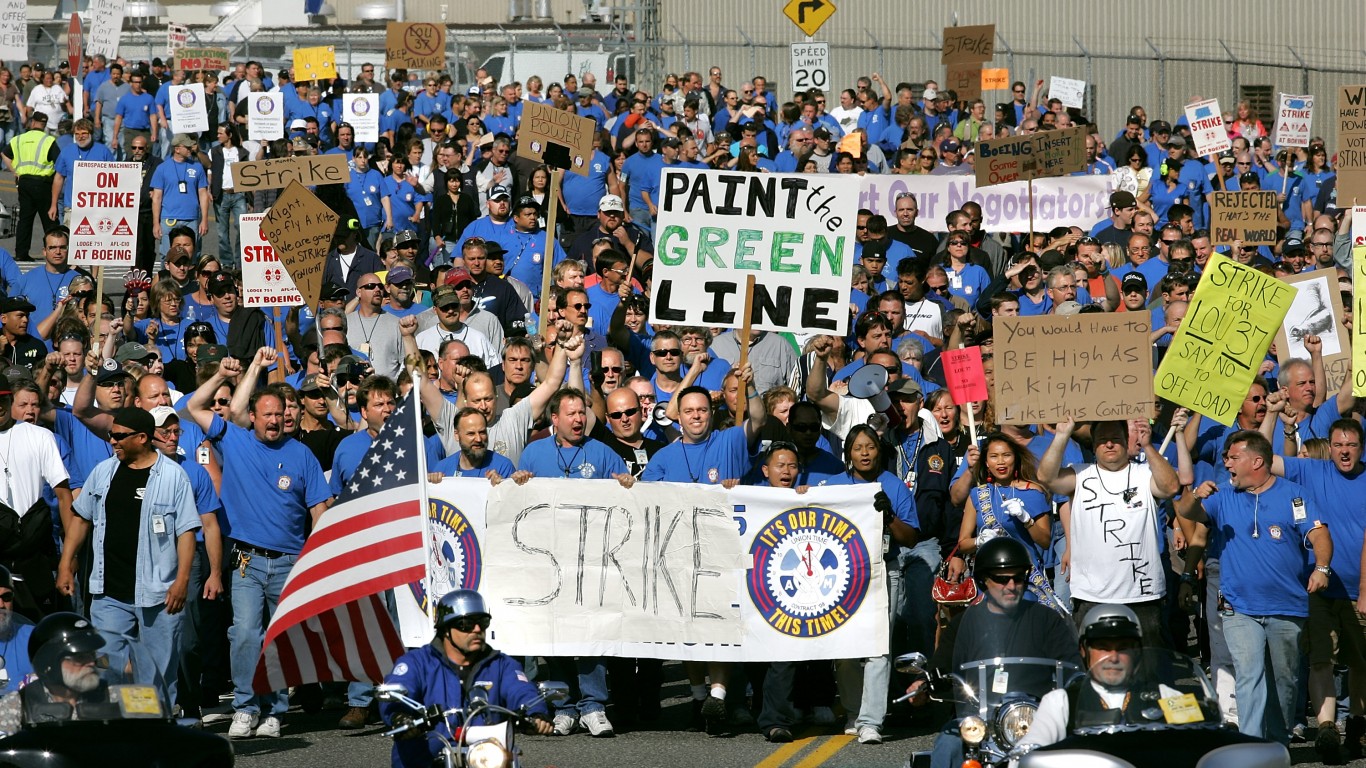
Published:

The coronavirus pandemic’s devastating effect on the world’s economies has shined a harsh light on the value of labor — it is the most vulnerable commodity in our economic system. In the countless examples of workers’ struggles in U.S. history, this power has been leveraged — with varying degrees of success — to negotiate and improve labor conditions across all manner of workplaces.
Many elements of gainful employment Americans may take for granted, such as health benefits, a living wage, and the 40-hour work week, were won by organized labor. These are the highest paying jobs in America.
Even though a wave of strikes hit the U.S. as recently as 2018, union membership has declined for decades. This pattern can be seen in our ranking of strikes by cumulative work stoppage days, with the nation’s largest worker actions tending to have occurred earlier than the less massive strikes. For a geographical perspective on union strength, here are the states with the strongest and weakest unions.
24/7 Wall St. reviewed data from the Bureau of Labor Statistics as well as media and archive reports on historic work stoppages to determine the largest worker strikes in American history.
Click here to see the 31 largest worker strikes in American history.
31. Detroit Newspapers Strike
> Duration: July 13, 1995 to Feb. 19, 1997
> No. of strikers: 2,500
> Cumulative days off the job: 1,012,500
Unions representing journalists, printers, truck drivers, maintenance workers, and other laborers went on strike over management’s attempt to create a merit-based raise system and limit overtime. The newspapers hired replacement workers, and the union called off the strike.
[in-text-ad]
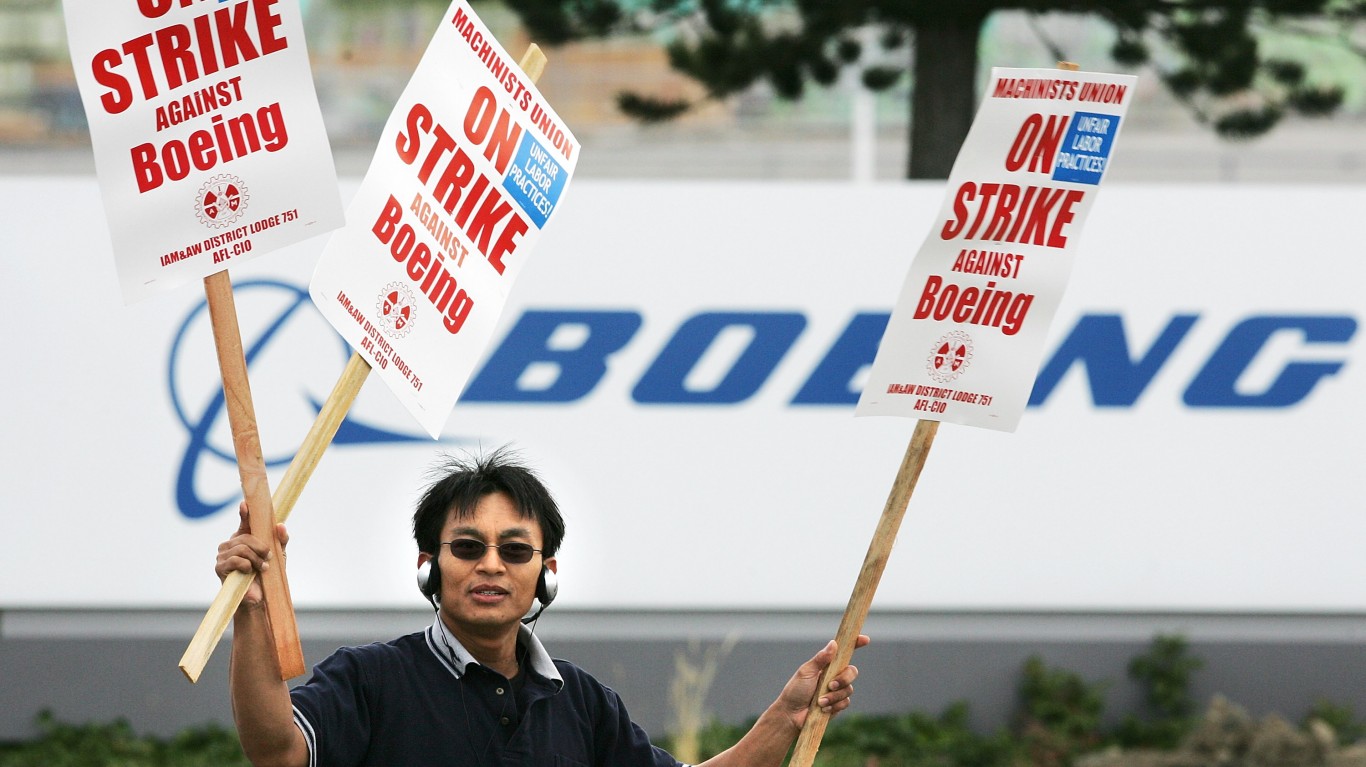
30. Boeing Machinists Strike of 2008
> Duration: Sept. 6, 2008 to Nov. 1, 2008
> No. of strikers: 27,000
> Cumulative days off the job: 1,053,000
The International Association of Machinists and Aerospace Workers ended an eight-week strike in November 2008 with an agreement that the union said protected factory jobs, prevented some outsourcing of posts at Boeing, and retained health care benefits. Boeing management said the accord gave the company more labor flexibility.

29. Wheeling Pittsburgh Steel Corp. Strike
> Duration: Oct. 1, 1996 to Aug. 12, 1997
> No. of strikers: 4,800
> Cumulative days off the job: 1,142,400
A 10-month strike involving steel workers at eight plants in three states ended in August 1997. The union said the agreement boosted pension benefits for the company’s steel workers and provided for early retirements. The accord allowed Wheeling to reduce workforce by 20%. The company closed in 2012.

28. Trucking Strike of 1994
> Duration: April 6, 1994 to April 29, 1994
> No. of strikers: 71,000
> Cumulative days off the job: 1,180,500
The 23-day strike, the nation’s longest trucker strike, ended on April 29, 1994. The agreement limited companies’ ability to hire part-time workers, paving the way for more items to be shipped by rail instead of by truck.
[in-text-ad-2]
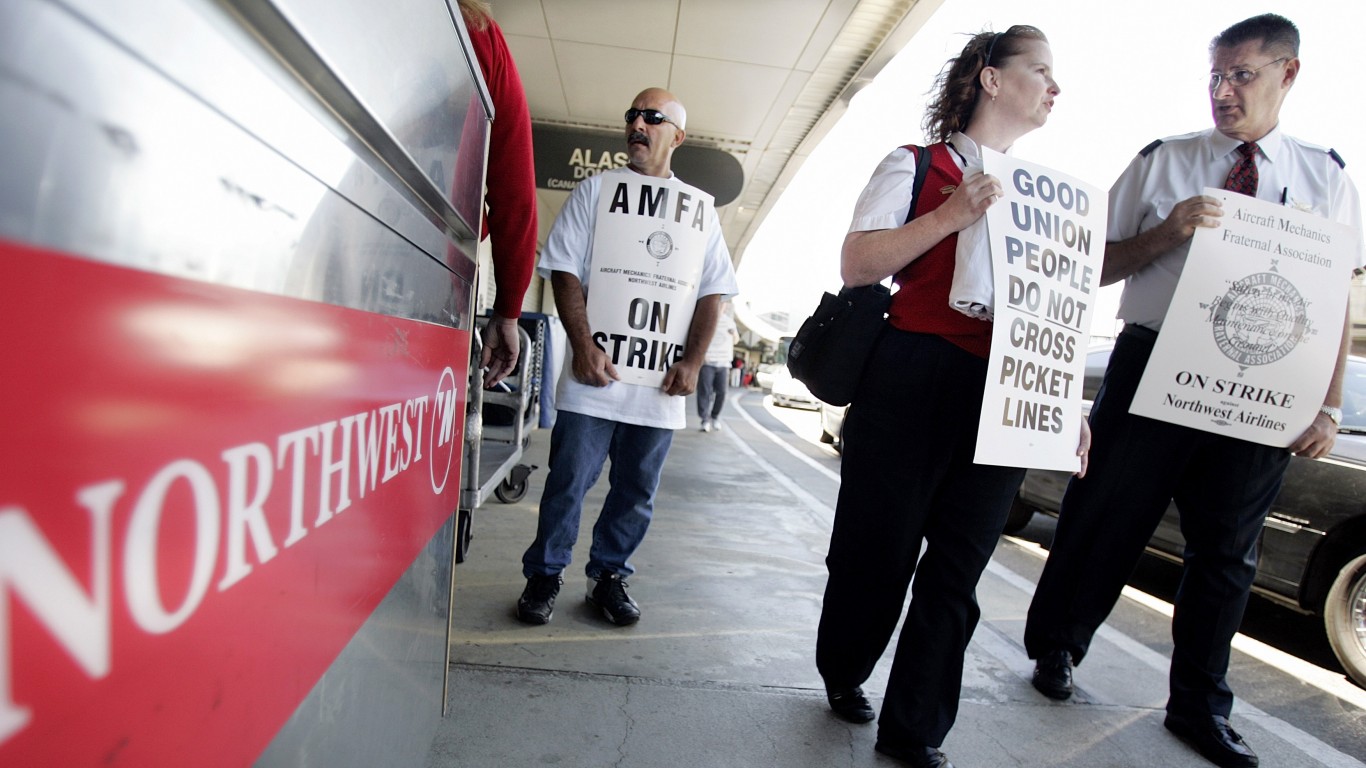
27. Northwest Airlines Strike
> Duration: Aug. 20, 2005 to Nov. 6, 2006
> No. of strikers: 3,000
> Cumulative days off the job: 1,183,800
The mechanics’ strike against Northwest Airlines proved to be a disaster for the striking workers and their union. Northwest replaced all of the strikers, and some of the strikers and laid-off workers crossed the picket line. The strike also failed because none of the other unions supported the picket lines.
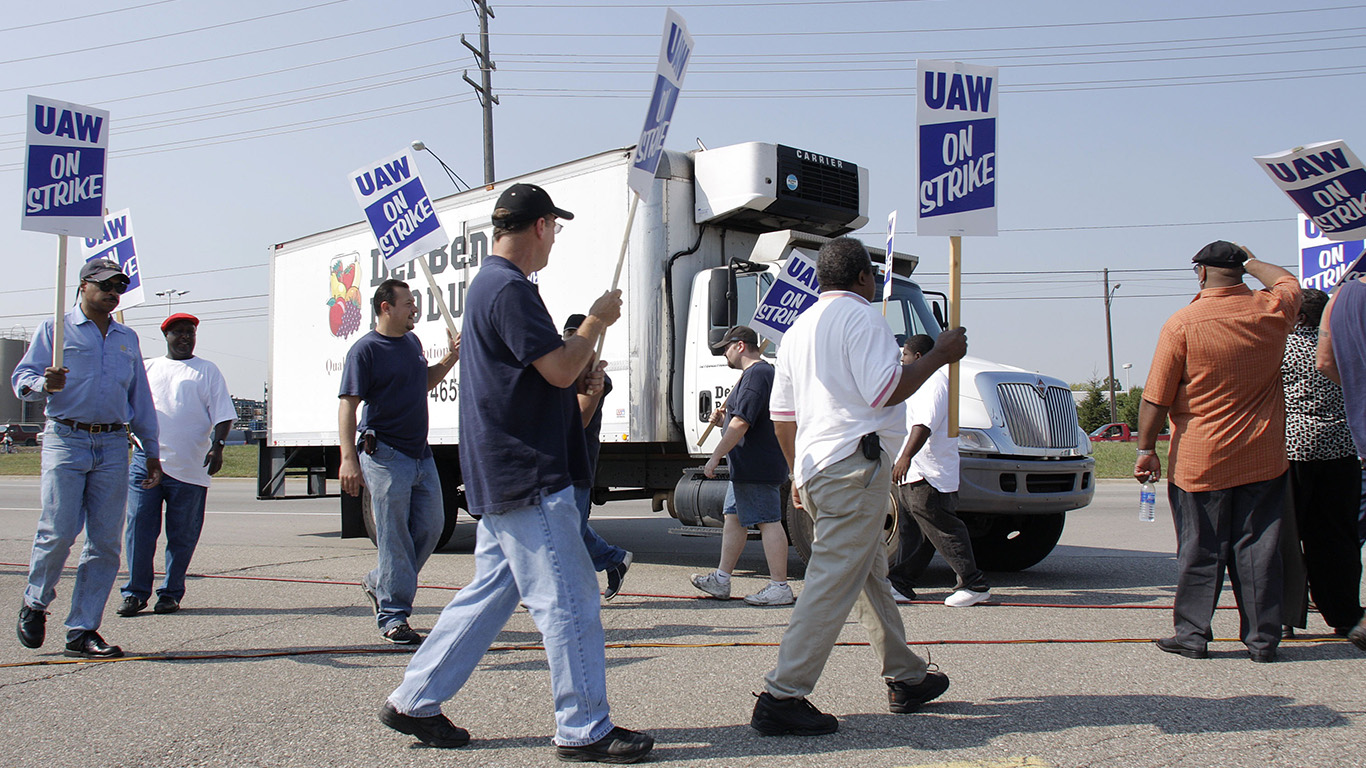
26. UAW Strike of 1996
> Duration: March 8, 1996 to March 22, 1996
> No. of strikers: 136,000
> Cumulative days off the job: 1,260,000
The United Auto Workers strike ended on March 22, 1996, when union leaders agreed to allow General Motors to outsource parts operations in exchange for the company’s promise to retain and add jobs at two plants.
[in-text-ad]
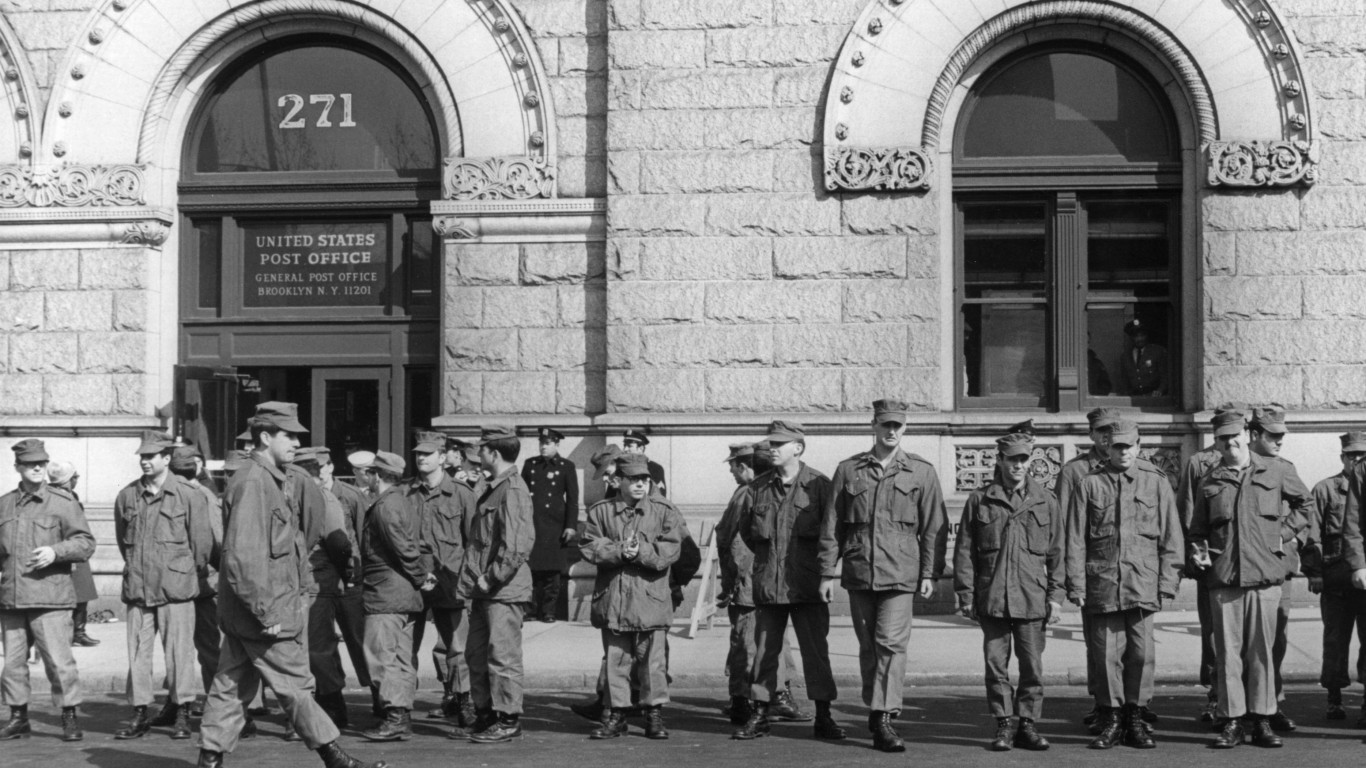
25. The U.S. Postal Strike of 1970
> Duration: March 18, 1970 to March 25, 1970
> No. of strikers: 210,000
> Cumulative days off the job: 1,260,000
More than 200,000 employees in 30 cities participated in the U.S. Postal Strike of 1970. Comprising a significant share of the nation’s 750,000 postal workers, activists halted mail service in New York, Detroit, and Philadelphia, triggering President Richard Nixon to declare a national emergency. Despite the military’s efforts to quell the strikes, a deal was eventually struck resulting in higher pay and better labor conditions under the Postal Reorganization Act of 1970.

24. General Motors Strike
> Duration: Sept. 16, 2019 to Oct. 25, 2019
> No. of strikers: 46,000
> Cumulative days off the job: 1,334,000
The work stoppage by the United Auto Workers in the fall of 2019, the longest against General Motors in 49 years, cost GM about $4 billion, according to the automaker. Under terms of the four-year accord, pay for older workers will increase 6% each year. Hourly workers were to receive an $11,000 signing bonus. The union also thwarted a company demand for workers to pay a greater share of health-care expenses.

23. Kaiser Aluminum Corp. Strike
> Duration: Oct. 1, 1998 to Sept. 18, 2000
> No. of strikers: 3,000
> Cumulative days off the job: 1,479,000
After several round of negotiations, aluminum workers rejected Kaiser’s proposal and went on strike on Sep 30, 1998. The union cited, among other issues, the company’s failure to repay losses incurred during compensation cut agreements made in the 1980s that were made to stave off bankruptcy. After nearly two years of numerous failed negotiations and snags, a deal was finally agreed upon on Oct 1, 2000.
[in-text-ad-2]

22. Boeing Strike of 1995
> Duration: Oct. 6, 1995 to Dec. 14, 1995
> No. of strikers: 33,000
> Cumulative days off the job: 1,551,000
Machinists and assembly line workers in 1995 won significant wage increases as a result of a strike that lasted over a month. Additionally, while Boeing would continue to increase its practice of contracting jobs overseas, the deal included the concession that any worker affected by subcontracting would be entitled to retraining for work elsewhere at the company.

21. Charter Communications Inc. Strike
> Duration: March 28, 2017 to ongoing
> No. of strikers: 1,800
> Cumulative days off the job: 1,578,600
Charter Communications workers started striking in March 2017 to fight changes to their retirement and health care benefits made after Charter acquired Time Warner and rebranded as Spectrum in 2016. The strike was the longest ongoing strike in the United States.
[in-text-ad]
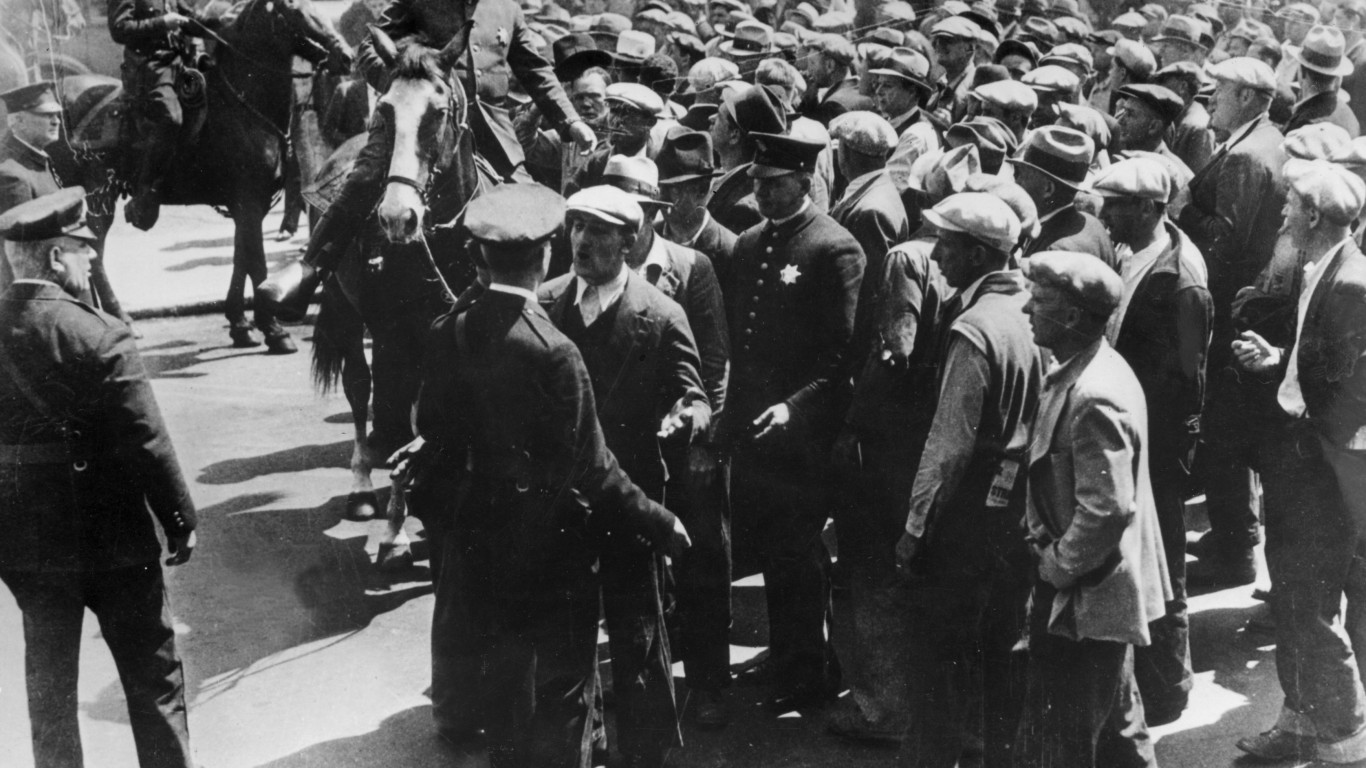
20. 1934 West Coast Waterfront Strike
> Duration: May 9, 1934 to July 17, 1934
> No. of strikers: 35,000
> Cumulative days off the job: 1,750,000
Starting with 12,000 dock workers in the spring of 1934, the West Coast Waterfront Strike included at its peak 35,000 laborers across various marine industries and lasted for 83 days. Though not included in the tally for this particular strike, Teamsters and other unions showing solidarity with the longshoremen brought the total workers on strike during this time to 130,000. The strikers achieved their goals through arbitration in October 1934 after ending the strike in July.

19. United Parcel Service Strike of 1997
> Duration: Aug. 4, 1997 to Aug. 21, 1997
> No. of strikers: 180,000
> Cumulative days off the job: 2,032,500
UPS workers represented by the Teamsters went on strike against the delivery services company over pay and benefits. The Teamsters agreed to a five-year contract after originally asking for a shorter-term deal. UPS agreed to create 10,000 full-time jobs from part-time posts, an increase from its original offer of only 1,000. The workers’ $8 an hour base pay was boosted by 50 cents an hour, and the average driver’s pay was lifted by $3.10 an hour over the life of the contract. UPS wanted to change the pension plan, but that plan remained in place, a victory for the union.

18. Bituminous Coal Operators Association Strike
> Duration: May 10, 1993 to Dec. 14, 1993
> No. of strikers: 16,800
> Cumulative days off the job: 2,203,000
The United Mine Workers of America agreed in December 1993 to end a strike that affected miners in five states by extending the contract that had lapsed the previous February. The dispute was over companies with union workers creating nonunion subsidiaries and transferring work to them. That issue was deferred.
[in-text-ad-2]
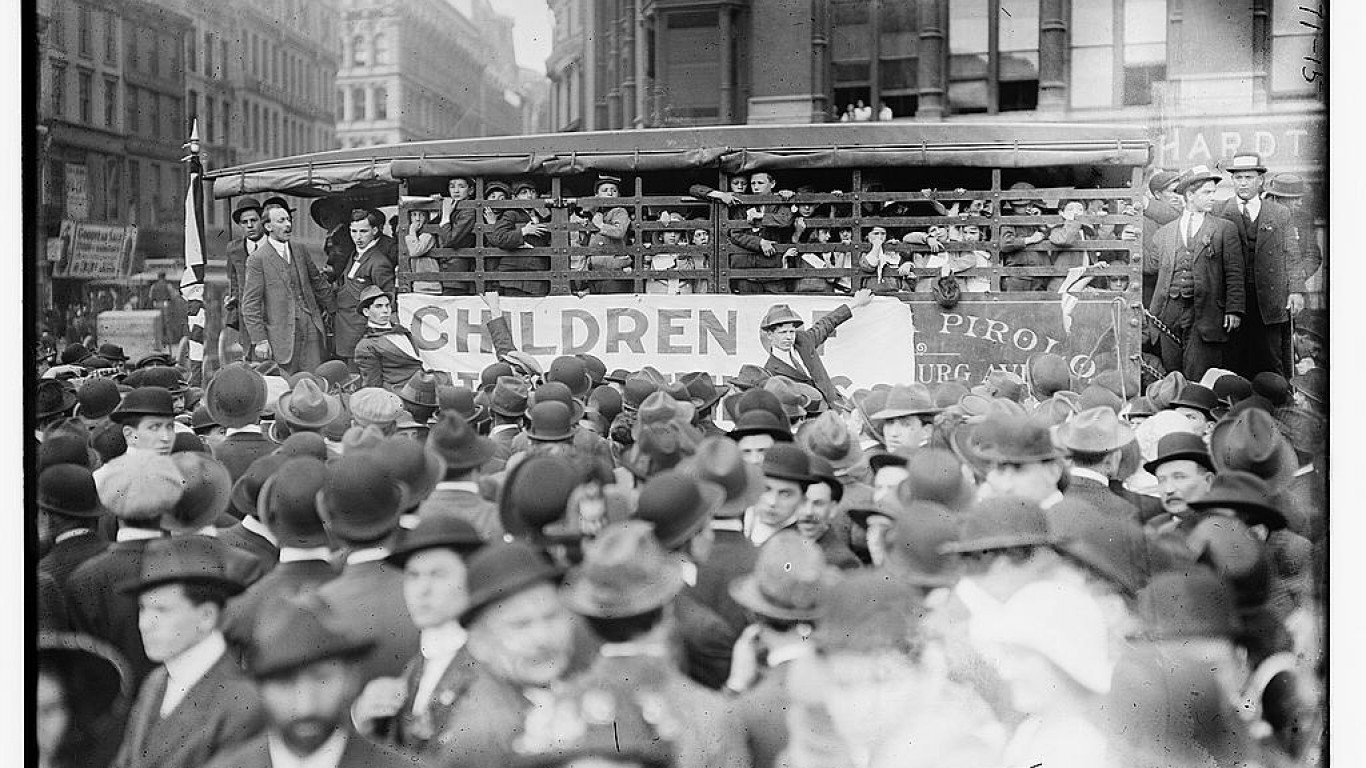
17. 1913 Paterson Silk Strike
> Duration: Feb. 25, 1913 to July 28, 1913
> No. of strikers: 23,000
> Cumulative days off the job: 2,530,000
Workers at silk mills in the New Jersey city that was one of the cradles of the Industrial Revolution went on strike over an increase in loom assignments to four from two that would have reduced the workforce. As the strike dragged on, sometimes turning violent, some strikers returned to work, while others who continued to strike were replaced. The strike succeeded in forcing the companies to delay the proposed workplace change.

16. The New York City Tugboat Strike of 1988
> Duration: Feb. 16, 1988 to Dec. 20, 1993
> No. of strikers: 1,600
> Cumulative days off the job: 2,895,200
Tugboat operators, whose ranks had been on the decline for many years, staged a failed strike that led to lower wages for many members of their union, The International Organization of Masters, Mates & Pilots.
[in-text-ad]

15. General Motors Strike
> Duration: June 5, 1998 to July 29, 1998
> No. of strikers: 152,200
> Cumulative days off the job: 3,313,000
A bitter strike at General Motors in 1998 ended after the automaker said it would not shutter factories where the workers were on strike and agreed to invest $180 million in new equipment at one of the facilities. The United Auto Workers agreed to work-rule changes that would increase production.

14. Caterpillar Strike
> Duration: June 20, 1994 to Dec. 3, 1995
> No. of strikers: 14,000
> Cumulative days off the job: 4,063,000
Union members at Caterpillar, the world’s largest heavy equipment manufacturer, returned to work in December 1995 after a failed long strike. Workers had gone on strike in June 1994, protesting unfair labor practices. They had been working without a contract since 1991. The new contract placed limits on job security and overtime pay, and gave Caterpillar leeway to lay off workers more frequently.
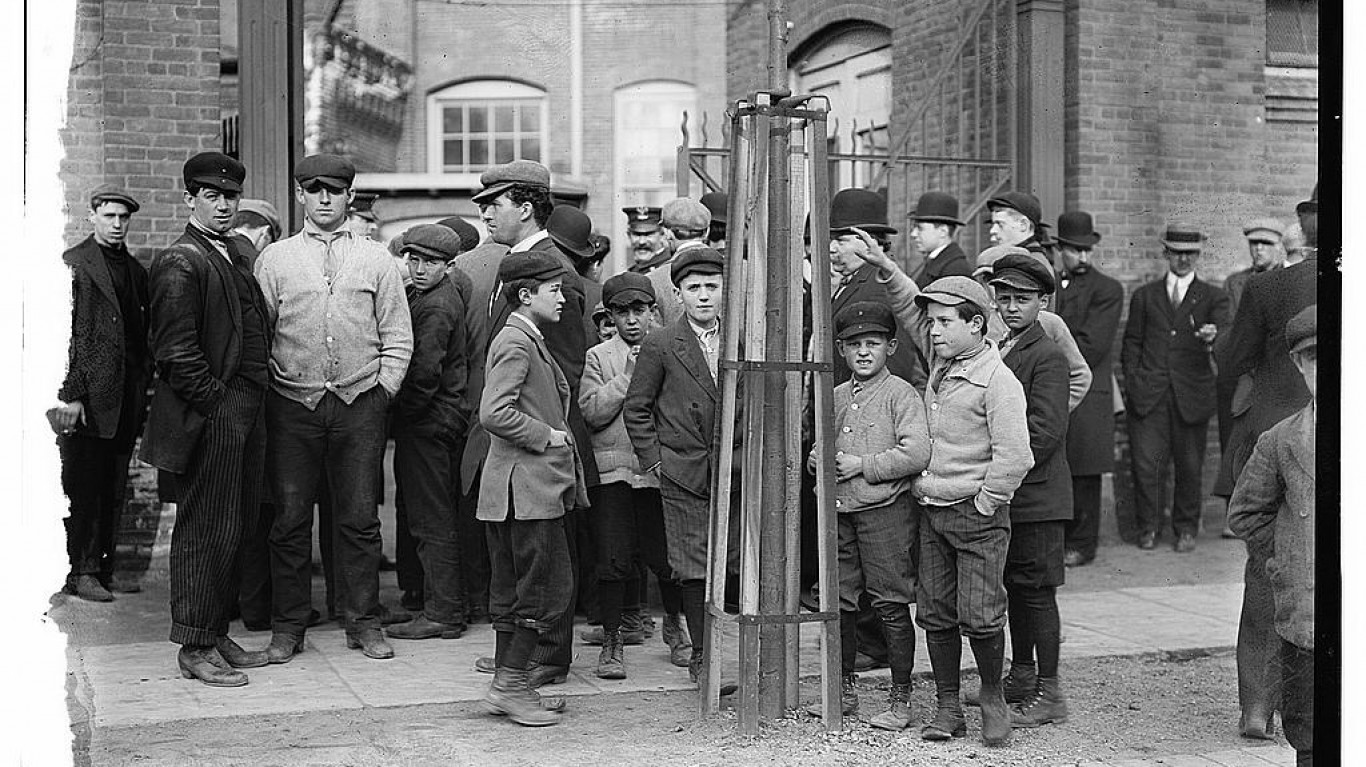
13. Passaic Textile Strike
> Duration: Jan. 25, 1926 to March 1, 1927
> No. of strikers: 15,000
> Cumulative days off the job: 4,215,000
The Passaic Textile Strike of 1926 involved more than 15,000 wool and silk workers in the Passaic, New Jersey, region. Workers reacted to a 10% pay cut and were galvanized later by police violence against demonstrators. Union demands included, among other items, time-and-a-half pay for overtime, a 40-hour workweek, sanitary working conditions, and no descrimination against union members.
The strike failed. Of the nine mills affected, even the few that settled disputes with workers broke their deals, firing many of the workers and rehiring them at lower wages.
[in-text-ad-2]
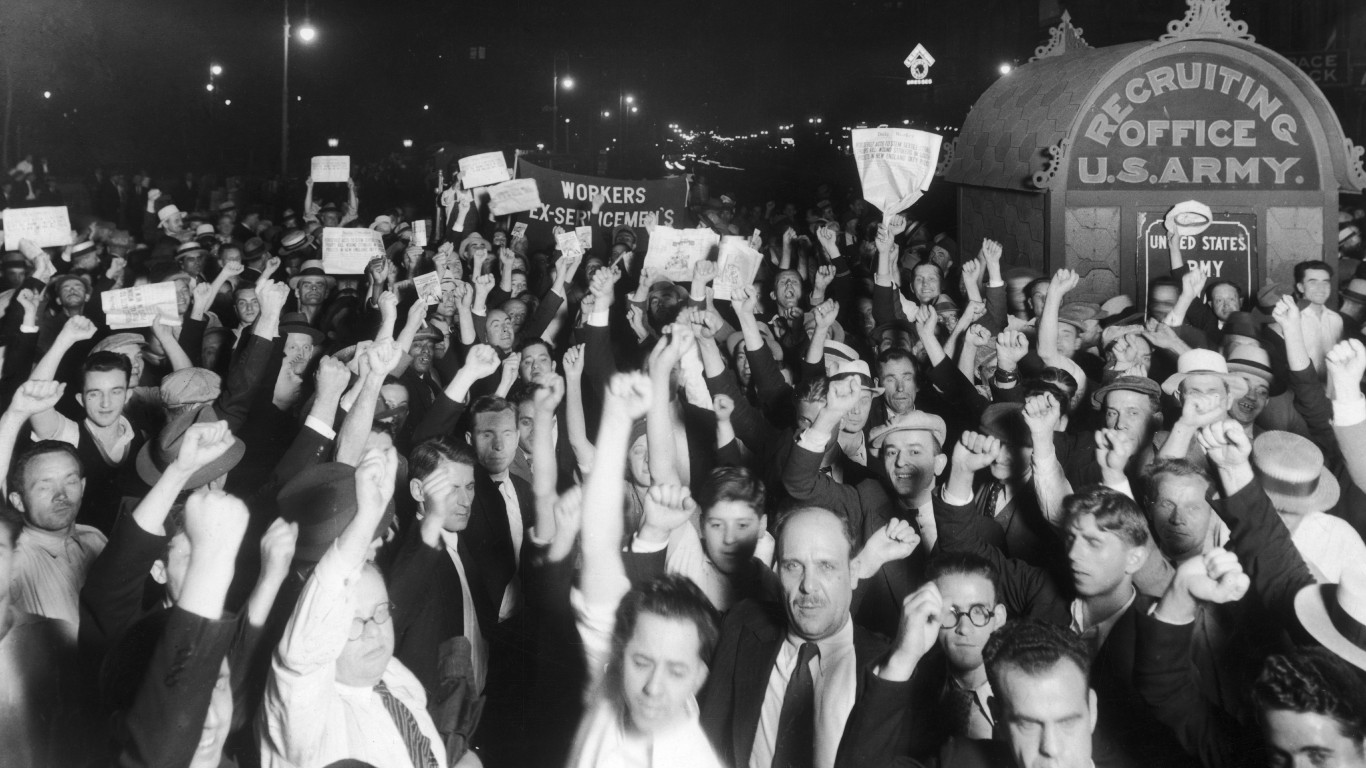
12. The 1934 Textile Worker Strike
> Duration: Sept. 3, 1934 to Sept. 23, 1934
> No. of strikers: 400,000
> Cumulative days off the job: 5,600,000
Textile workers went on strike to protest a cut in pay as their workweeks were being reduced. The strike idled the textile industry in North Carolina. The workers, however, lacked the means to continue the struggle. Their cause was also undermined by a glut of textile inventory. In September, President Franklin Roosevelt personally intervened to ask the workers to return to the mills and they did so.
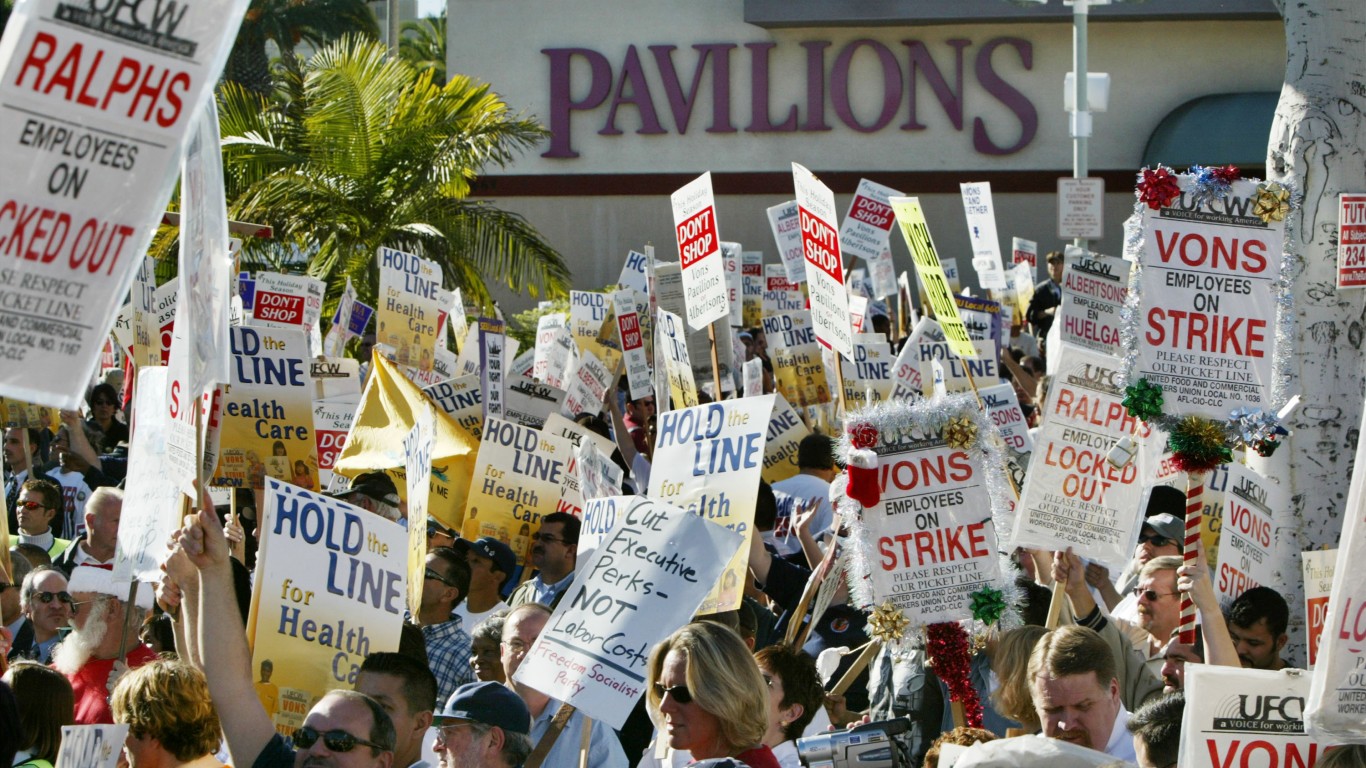
11. Southern California Supermarket Strike
> Duration: Oct. 12, 2003 to Feb. 29, 2004
> No. of strikers: 67,300
> Cumulative days off the job: 5,718,100
Workers represented by United Food and Commercial Workers went on strike against supermarket company Von’s because management wanted to change the health benefits of workers, which under the expiring contract were paid by the company. Soon afterward, supermarket companies Ralphs and Albertson’s, whose contracts with their unions were also terminating, locked out employees. After a nearly five-month strike, management succeeded in getting workers to pay more for their health care benefits.
[in-text-ad]

10. The 1946 Union of Electrical, Radio and Machinist Workers’ Strike
> Duration: Jan. 15, 1946 to March 14, 1946
> No. of strikers: 174,000
> Cumulative days off the job: 7,308,000
Accruing 7.3 million days of work stoppage at a time when unions had considerably more power than they do today, the 1946 strike by electrical workers is the 10th largest in U.S. history. Starting in mid-January, after months of negotiations for higher wages, about 174,000 employees of several large electrical manufacturing companies went on strike. The strike was part of several massive organized labor campaigns conducted in 1946.
The wave of strikes at the time led to President Harry Truman’s Labor Management Relations Act of 1947, also known as the Taft-Hartley Act, which restricted the power of labor unions and is still in force today.
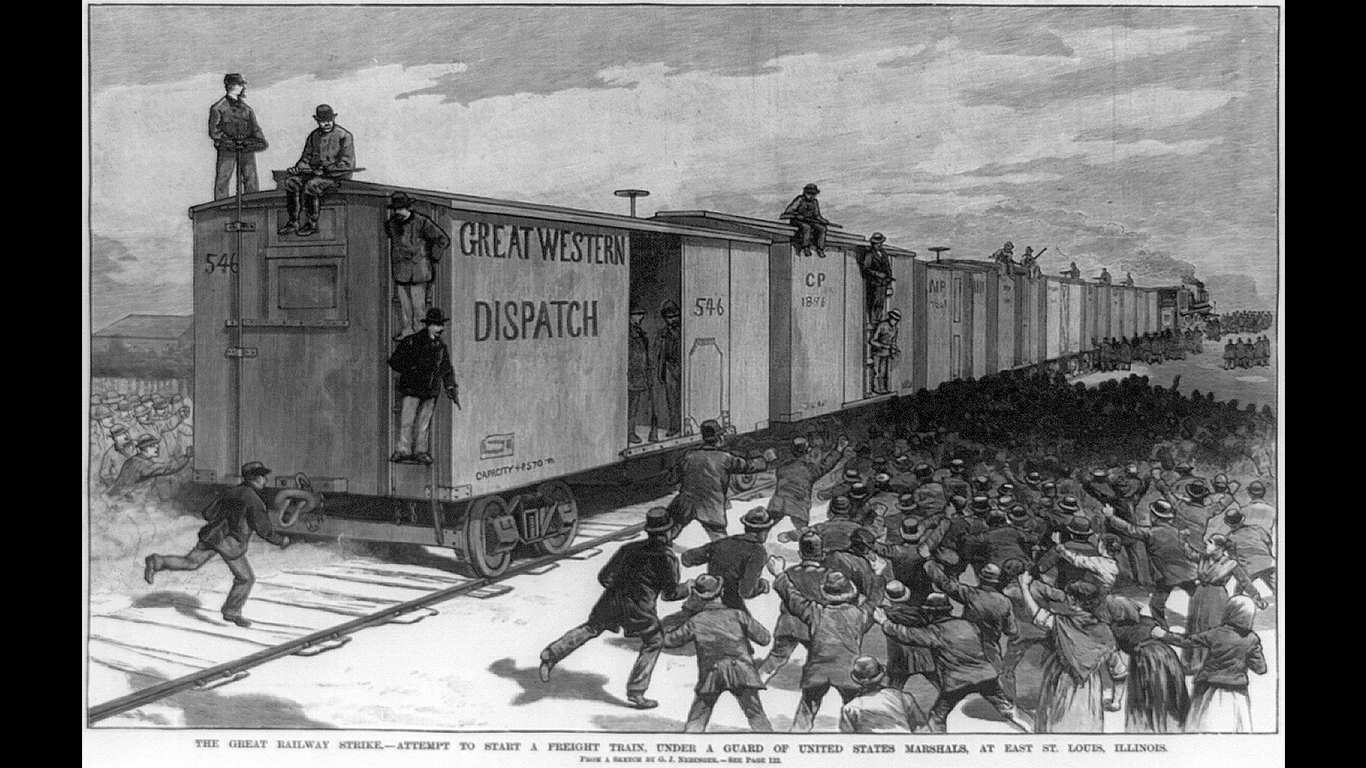
9. The Great Southwest Railroad Strike
> Duration: March 1, 1886 to May 4, 1886
> No. of strikers: 200,000
> Cumulative days off the job: 9,400,000
As railroads were rapidly expanding throughout the American West in the late 19th century, railroad workers went on strike in what is known as The Great Southwest Railroad Strike. Workers began protesting the grueling work hours and brutal conditions. The strike against the Union Pacific Railroad and the Missouri Pacific Railroad began after a railroad employee was fired for attending a union meeting in Texas. The job action spread to four other states and turned violent. The railroads hired replacement workers, and the strike faltered when other unions failed to support the strikers.

8. Pullman Strike
> Duration: May 11, 1894 to July 20, 1894
> No. of strikers: 260,000
> Cumulative days off the job: 13,260,000
Due in part to the fallout from the economic recession between September 1893 and May 1894, railroad car manufacturer Pullman Palace Car Company cut pay by about 25% for workers without reducing living expenses in the company town near Chicago, where they lived. When workers presented the problem to company president George M. Pullman — the possibility of starvation added to already poor living conditions, low wages, and a 16-hours workday — they were fired.
By mid-summer, hundreds of thousands of workers were on strike. A federal court-issued injunction and the military were needed to suppress the workers. President Grover Cleveland declared Labor Day a national holiday during the strike.
[in-text-ad-2]

7. Anthracite Coal Strike of 1902
> Duration: May 12, 1902 to Oct. 23, 1902
> No. of strikers: 147,000
> Cumulative days off the job: 15,141,000
The Anthracite Coal Strike of 1902 pitted coal miners in Pennsylvania who wanted higher pay and shorter work hours against coal mine companies that claimed their operations were not that profitable. The strike led to the formation of a commission that arbitrated an agreement that included pay increases and reduced work hours. It marked the first time the federal government intervened as a neutral party and not on the side of employers. The job action also boosted the labor movement.

6. American Association of Advertising Agencies Strike
> Duration: May 1, 2000 to Oct. 30, 2000
> No. of strikers: 135,000
> Cumulative days off the job: 17,280,000
Actors belonging to the Screen Actors Guild and the American Federation of Television & Radio Artists ended their strike American Association of Advertising Agencies in October of 2000. The union defeated an attempt by the American Association of Advertising Agencies and the Association of National Advertisers to discontinue residuals paid to actors for television commercials.
[in-text-ad]

5. United Auto Workers Strike of 1945
> Duration: Nov. 21, 1945 to March 13, 1946
> No. of strikers: 225,500
> Cumulative days off the job: 17,363,500
After abiding by a no-strike vow during WWII and deferring wage increase demands, organized labor asked for higher pay once the war ended, and the automobile sector was on exception. The United Auto Workers requested a 30% wage hike in November of 1945. GM countered with a 10% increase. Negotiations reached an impasse, and the laborer began work stoppage. The job action ended when GM said it would give workers a 17.5% pay hike, paid vacation, and overtime pay.
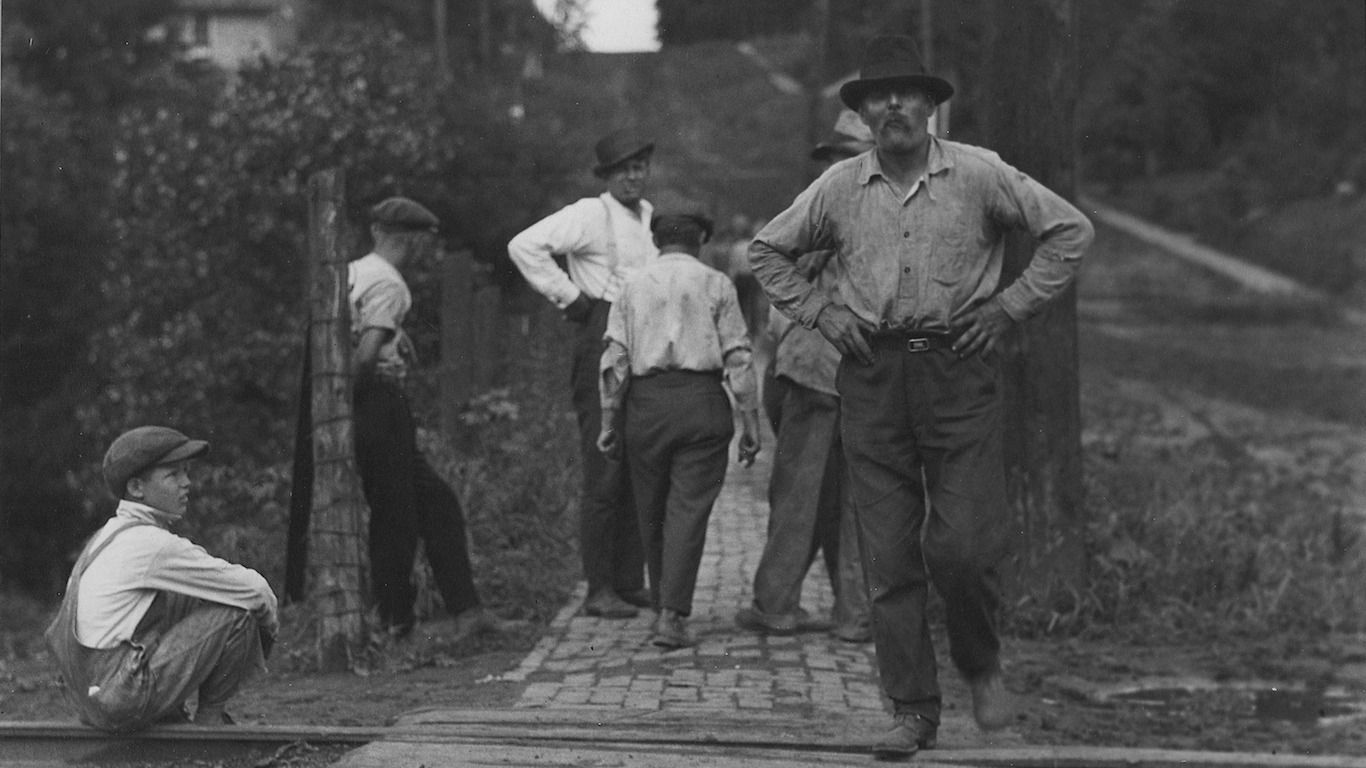
4. The Railroad Shop Workers Strike
> Duration: July 1, 1922 to Sept. 1, 1922
> No. of strikers: 400,000
> Cumulative days off the job: 18,000,000
In response to a 12% wage cut, about 400,000 railroad workers went on strike on July 1, 1922. While nearly the largest strike in U.S. history, the workers were ruthlessly broken by various violent measures, including the hiring of 16,000 gunmen, National Guard deployment, and targeted hits by private detectives.
The unrest demonstrated in the Railroad Shop Strike led to the passage of the Railway Labor Act, which provided the right for workers to organize and join unions.
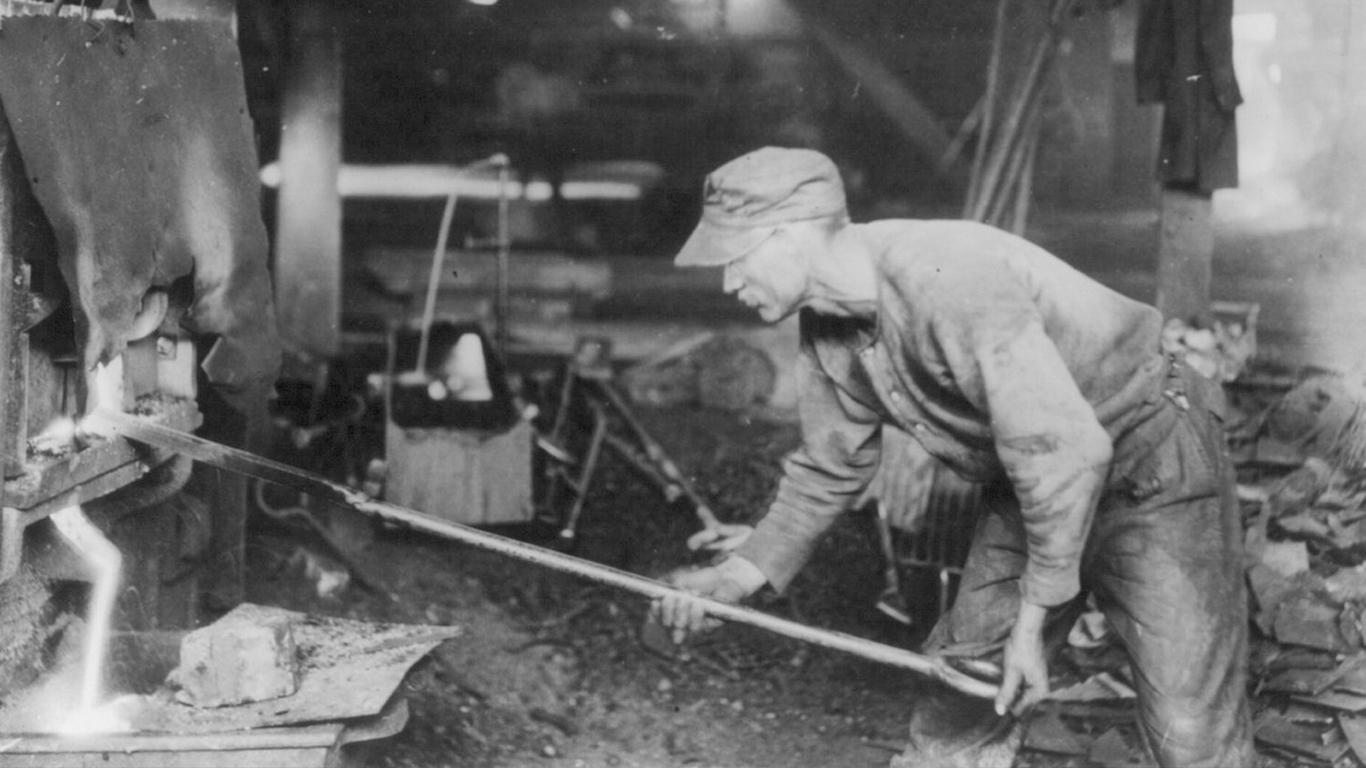
3. The Steel Strike of 1919
> Duration: Sept. 22, 1919 to Jan. 8, 1920
> No. of strikers: 350,000
> Cumulative days off the job: 26,600,000
Disagreements between labor and management in the steel industry had been mediated by the War Labor Board during World War I. After the war ended, however, workers claimed companies refused to recognize unions. Workers claimed companies refused to recognize unions. Postwar inflation was also eroding incomes. Steel workers went on strike in September 1919, but the job action was hampered by bad organization as well as ethnic and racial tensions within the steel union. Also, management exploited the public’s fears of Bolshevism. Strikers crossed picket lines, and the strike ended unsuccessfully for the unionized steel workers.
[in-text-ad-2]

2. The Steel Strike of 1959
> Duration: July 15, 1959 to Nov. 1, 1959
> No. of strikers: 500,000
> Cumulative days off the job: 38,000,000
In mid-July, 1959, around 500,000 steel workers walked off the job in defiance of President Dwight D. Eisenhower’s pleas to continue bargaining. The strikers’ goal was to amend a clause in their union contract to give management more control over the number of workers assigned to a task, as well as the power to introduce new work rules or machinery that would affect how many employees or hours were needed.
The union ended up victorious, although the strike is considered to have led to increases in foreign steel imports — a trade pattern that would ultimately hurt American steel workers.
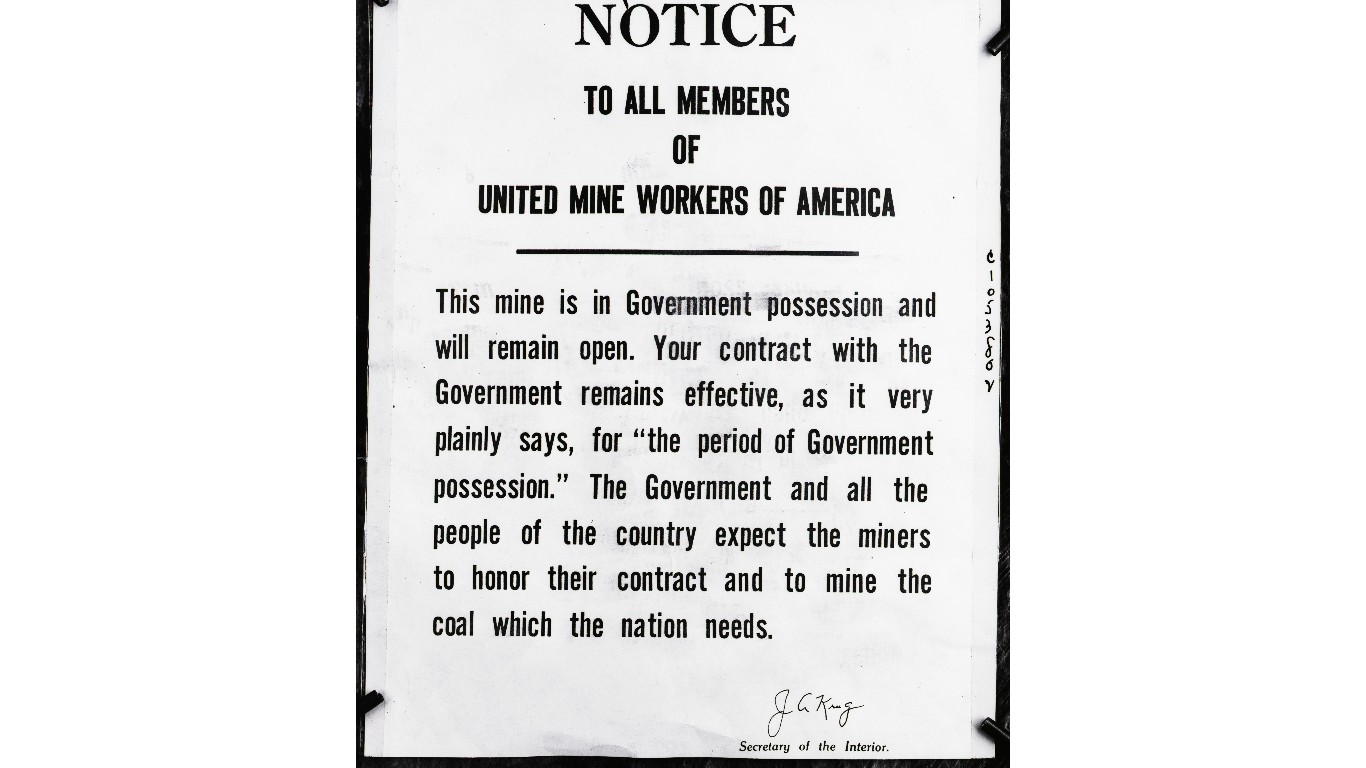
1. United Mine Workers of America Strike of 1946
> Duration: April 1, 1946 to Dec. 7, 1946
> No. of strikers: 400,000
> Cumulative days off the job: 70,400,000
The United Mine Workers of America, under the leadership of legendary union boss John L. Lewis, went on strike in April 1946, seeking a health plan for workers and retirees. As the strike dragged on, President Harry Truman stepped in and placed the mines under the control of the federal government. Eventually, the government forged an agreement with the union that returned control of the mines to companies and provided for raises in pay and improvements in mine safety, as well as establishing a framework for creating a retirement fund.
The thought of burdening your family with a financial disaster is most Americans’ nightmare. However, recent studies show that over 100 million Americans still don’t have proper life insurance in the event they pass away.
Life insurance can bring peace of mind – ensuring your loved ones are safeguarded against unforeseen expenses and debts. With premiums often lower than expected and a variety of plans tailored to different life stages and health conditions, securing a policy is more accessible than ever.
A quick, no-obligation quote can provide valuable insight into what’s available and what might best suit your family’s needs. Life insurance is a simple step you can take today to help secure peace of mind for your loved ones tomorrow.
Click here to learn how to get a quote in just a few minutes.
Thank you for reading! Have some feedback for us?
Contact the 24/7 Wall St. editorial team.